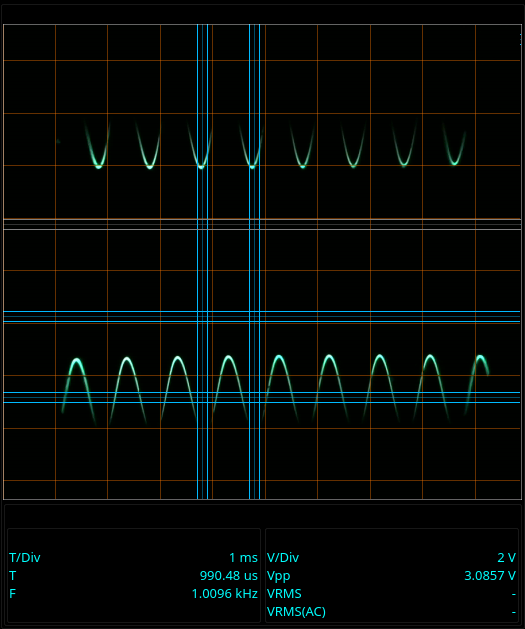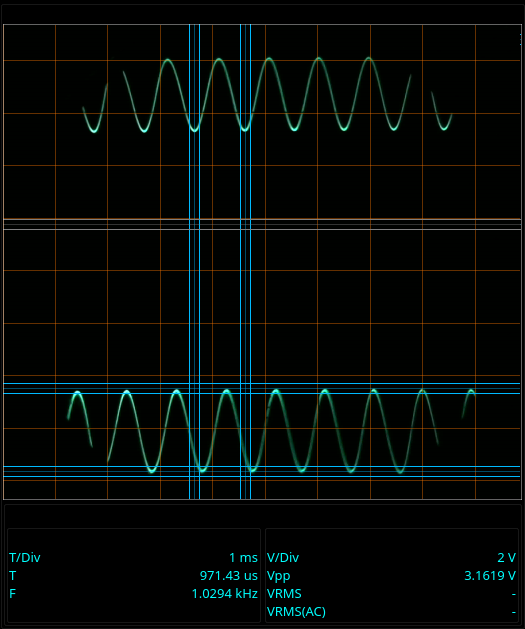Dual traces and the Telequipment D43 oscilloscope
That ain’t fair, there’s twos of you there.
My Telequipment D43 projects - Table of Contents
I heard back from the fellow who recently asked about fixing the high voltage supply in his D43. He got it running, and sent me some photos.
| Johan’s D43 Repair |
|---|
 |
 |
 |
Johan’s is a bit neater than mine because he got hold of a really high voltage (6000VDC) capacitor for one of the replacements, and a 2000VDC replacement for the other. I used multiple capacitors to get the needed voltage ratings and capacitance values. Mine works, but it doesn’t look that nice. Johan’s works, and looks good too. The 2000VDC part put me in a panic for a moment because I used a higher voltage rating in mine. A quick look at the parts list of the D43 showed that C403 is indeed rated for 2000VDC, so everything is fine.
Along with the photos, Johan also mentioned a slight oddity in the display of the D43. It’s a normal thing on a D43, but not something you’ll see on many other scopes.
First the pictures:
| Trace oddity |
|---|
 |
 |
The first photo shows what appears to be a cut off trace on the bottom edge of the display. The second shows the trace when it is in the middle of the display.
The cutoff area is normal. In fact, there are two cutoff areas.
The cathode ray tube (CRT) in the D43 has two electron guns in it, and displays both traces simultaneously. Most “dual trace” scopes only have a single electron gun, and alternate which input they are displaying.
Because of the dual guns in the D43 CRT, there’s also a sort of “guard plate” (or two) that keeps the deflection plates for the two guns from interfering with each other. Those guard plates are the reason for the cutoff areas in the display of the D43.
If you examine the two traces on the display, you’ll find that the upper channel has a cutoff area at the bottom of the CRT and that the lower channel has a cutoff area at the top of the display.
Like this:
| Two traces, two cutoff areas |
|---|
 |
 |
 |
The first picture shows two traces in the normal area of the display.
The second image shows the cutoffs at the top and bottom that happen when you move the lower channel to the upper edge of the display or the upper channel to the lower edge of the display.
The third image is what happens when you move the upper channel to the top of the display and the lower channel to the lower edge of the display - each channel can drive its trace to the extremity of its part of the display.
The dual gun CRT is good if you are looking at “fast” signals. The J-type vertical amplifier modules Johan and I have in our D43s are rated to 35MHz - if they are properly adjusted. Mine probably aren’t.
At any rate, you can get the full bandwidth on both channels at the same time on a D43.
Other analog scopes that have a single gun but two traces have to either alternate the two traces (so you can’t see if rising edges on two signals are really synchronous) or they “chop” the signals and display pieces of both in one scan.
With alternate you can’t see synchronous events, with chop you lose half the bandwidth (or more.)
The advantages of the D43 dual trace CRT (and associated circuitry) comes at a cost, though.
One thing it costs you is the cutoff areas for each trace.
The other thing the D43 cannot do is to display the difference of two inputs.
That’s a trick that’s often used to simulate a differential input. The two D43 vertical amplifiers each drive a single trace. The vertical amplifiers are modular, and completely independent of one another. There’s just no realistic way to have built in a difference function and kept the two modules each driving a separate trace.
There you have it.
If the trace on your D43 has a cutoff area at the top or bottom of the display, then the scope isn’t broken.
It’s just showing you that it’s got an unfair advantage over dual trace, single gun analog oscilloscopes.
The images of the dual traces on my D43 were made with my Digital D43 oscilloscope camera software.
Check out the Digital D43 Wiki and see how to make photos and measurements from your analog oscilloscope - from any analog oscilloscope, not just a D43.
What odd feature does your scope have that you’ve never seen anywhere else? Post a comment and let me know.